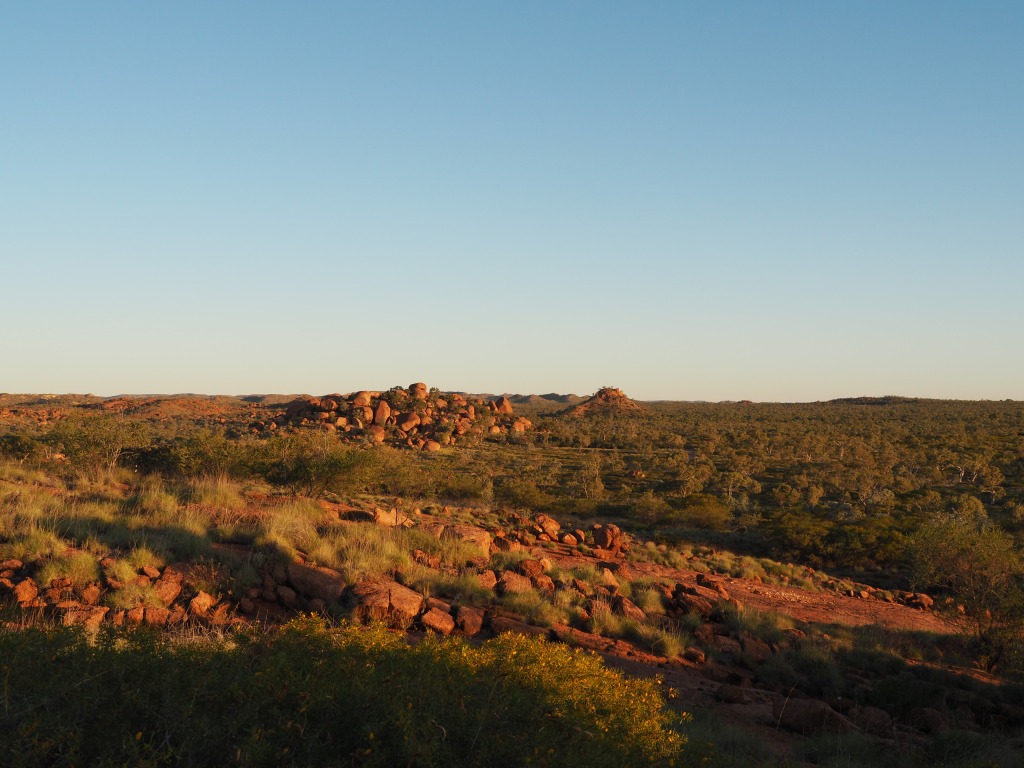Generally speaking, the first thing that anyone notices about Mount Isa, whether flying in or driving in, is the Mount Isa Mine. It dominates the view from all directions. For almost 100 years, Mount Isa’s vast mineral wealth — its copper, lead, silver and zinc — is what the city has been best known for. But the Mount Isa region (the traditional lands of the Kalkadoon peoples for over 40,000 years) is also rich for another reason — its beautiful, ancient landscape.

Photo: © Trisha Fielding 2022.
Apart from the mine, which, let’s face it, cannot be unseen — one of the first things I noticed when I landed in Mount Isa for the first time (on a research trip for a history book I’m writing) was a profusion of wildflowers that lined the roadside from the airport to the city. The clumps of Mulla Mulla (Ptilotus exaltatus) — a native of arid and semi-arid areas of Australia — with its conical-shaped, pinkish/mauve-coloured flowers, proved to be a prelude to the natural attractions of the area.

Photo: © Trisha Fielding 2022.
For a start, there is abundant bird life here. One afternoon I drove out to Lake Moondarra, about 17km from Mount Isa, to do some exploring. This lake was created in 1957 when a dam was built on the Leichhardt River to provide the inhabitants of Mount Isa with a reliable water supply. I spent a very pleasant couple of hours out here, wandering around in the scrub out the back of the dam spillway, carefully trying to avoid scratching my legs too much on the spinifex grass. I saw a pair of galahs picking at the rough, rocky ground; a Red-winged parrot; a Cloncurry Ringneck parrot; a few crested pigeons; and several yellow-throated miners.
On Sunday afternoon, I was fortunate to have friends (who are locals) drive me out to a place they called “the granites” to watch the sun set. It’s an abandoned granite mine, technically part of the Sybella granite batholith* — and geologically, it’s estimated to be around 1,660 million years old. That’s an impressive timescale. Situated on private property, the site is about 20km outside of Mount Isa, and accessible by 4WD vehicle only. After passing through an unmarked gate, a dirt track soon winds past a field of monolithic lumps of granite, mined but later abandoned, all laying about like some kind of collapsed Stonehenge in outback Queensland.

Photo: © Trisha Fielding 2022.

Photo: © Trisha Fielding 2022.

Photo: © Trisha Fielding 2022.
A little farther on, a massive outcrop of pink granite rises up from the track, scattered with rust-coloured spherical boulders, often stacked impossibly precariously on top of each other. Soon, the granite outcrop flattens out, allowing a panoramic view of the entire plain below it. It’s a spectacular scene that stretches far off to the horizon, where the sun drops rapidly behind the ranges. As the last of the light faded, the rocks behind us began to change colours, assuming a luminous, ethereal quality that was spellbinding. It’s an afternoon that I won’t soon forget.

Photo: © Trisha Fielding 2022.
On the flight out to Mount Isa, I was re-reading the book Travels in North Queensland, by the writer Jean Devanny. She is best remembered as an author of fiction, but it is her non-fiction “travel books” (of which Travels in North Queensland is one) that interest me the most. Devanny (writing in the mid-20th century) thought that the town of Mount Isa itself was “vital and captivating” and “intriguing and alive”, and the scenery leading out to Mount Isa beautiful, but when it came to Mount Isa’s natural attributes, she was apparently less than impressed.
The road and railway line out to Mt Isa, which mostly ran parallel, traversed narrow levels between ironstone ridges stained puce, purple, red, blue, cinnamon and rust. Broken rocks disclosed the yellow heart of crumbled hills. The earth itself was honey brown. On all sides rose well-timbered tors, flat-topped, peaked or rounded. All the cattle, even in patches of spinifex, were fat.
But Mt Isa itself, sprawled over a lumpy arid basin encircled by ironstone hills [was] for the most part barren of vegetation and minus the aforesaid colouring.
Jean Devanny, Travels in North Queensland, 1951.

Photo: © Trisha Fielding 2022.
Perhaps if Devanny had been able to see Mount Isa from the air, as I had done when I flew in, she might not have thought it to be so devoid of colour? The cinnamon and rust coloured ridges of the Selwyn Range and the honey-brown earth were certainly there — in my eyes at any rate. Perhaps we really only see what we want to see?
I’ll admit I was lucky enough to have been shown around all the scenic parts of Mount Isa by my friends. I wish Devanny had seen those granite spheres at sunset.
* A very large irregular-shaped mass of igneous rock, especially granite, formed from an intrusion of magma at great depth.








A lovely account. I can’t decide which is my favourite photo – the soft grey-green vegetation against the pinky soil and rocks in photo #5, the red-gold glow of those batholith spheres, or the tender pink fluffiness of the mulla mulla – which looks altogether too soft and vulnerable for such a challenging environment. It’s easy to see why Devanny was impressed by the colours of the landscape beyond the town – what a wonderful list of colours she assembled. Great observational powers.
LikeLiked by 1 person